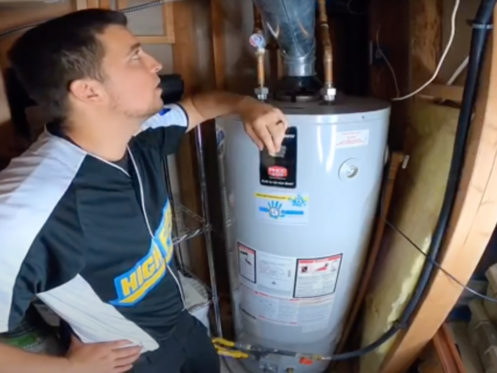Just how do you actually feel about How to Maintain Your Water Heater & Prolong its Life?

Warm water is crucial for day-to-day convenience, whether it's for a rejuvenating shower or washing meals. To guarantee your warm water system runs successfully and lasts much longer, normal upkeep is key. This write-up gives useful suggestions and insights on how to maintain your home's warm water system to stay clear of interruptions and expensive repair work.
Intro
Preserving your home's hot water system might seem difficult, but with a couple of straightforward actions, you can ensure it operates efficiently for several years to find. This guide covers everything from recognizing your warm water system to DIY maintenance ideas and knowing when to call in professional help.
Relevance of Keeping Your Warm Water System
Routine maintenance not only extends the lifespan of your hot water system yet additionally ensures it operates effectively. Disregarding maintenance can lead to decreased effectiveness, higher energy costs, and also premature failure of the system.
Signs Your Warm Water System Demands Maintenance
Knowing when your warm water system requires interest can prevent significant problems. Keep an eye out for signs such as inconsistent water temperature level, strange sounds from the heater, or corroded water.
Comprehending Your Hot Water System
Before diving right into maintenance tasks, it's handy to comprehend the basic components of your warm water system. Usually, this consists of the hot water heater itself, pipelines, anode poles, and temperature controls.
Month-to-month Upkeep Tasks
Normal regular monthly checks can help capture small problems before they rise.
Flushing the Hot Water Heater
Flushing your water heater gets rid of debris accumulation, improving effectiveness and prolonging its life.
Monitoring and Replacing Anode Rods
Anode poles avoid corrosion inside the storage tank. Inspecting and changing them when worn out is crucial.
Checking and Readjusting Temperature Setups
Changing the temperature level settings makes certain optimal performance and safety.
Do It Yourself Tips for Maintenance
You can perform numerous maintenance tasks on your own to keep your warm water system in leading condition.
Looking for Leaks
Regularly evaluate pipes and links for leakages, as these can lead to water damages and higher costs.
Checking Stress Relief Valves
Testing the stress relief valve guarantees it functions properly and protects against too much pressure accumulation.
Insulating Pipes
Protecting warm water pipes decreases warm loss and can conserve energy.
When to Call an Expert
While do it yourself maintenance is useful, some concerns require professional knowledge.
Facility Issues Requiring Expert Aid
Examples include major leaks, electric troubles, or if your hot water heater is regularly underperforming.
Routine Expert Upkeep Conveniences
Specialist upkeep can consist of thorough examinations, tune-ups, and making certain conformity with safety and security criteria.
Verdict
Routine maintenance of your home's hot water system is important for effectiveness, long life, and cost savings. By adhering to these ideas and recognizing when to look for expert assistance, you can guarantee a reliable supply of warm water without unforeseen disturbances.
How to Maintain an Instant Hot Water Heater
- Before tinkering with your hot water heater, make sure that it’s not powered on. You also have to turn off the main circuit breaker and shut off the main gas line to prevent accidents. Also turn off the water valves connected to your unit to prevent water from flowing into and out of the appliance.
- 2. When you’re done, you have to detach the purge valves’ caps. These look like the letter “T†and are situated on either side of the water valves. Doing so will release any pressure that has accumulated inside the valves while at the same time avoid hot water from shooting out and burning your skin.
- 3. When the purge valves’ caps are removed, you have to connect your hosing lines to the valves. Your unit should have come with three hoses but if it didn’t, you can purchase these things from any hardware or home repair shops. You can also get them from retail stores that sell water heating systems. Read the user’s manual and follow it to complete this task properly. When the hosing lines are connected, open the purge port’s valves.
- 4. You should never use harsh chemical cleaners or solutions when cleaning your unit. Make use of white vinegar instead. It should be undiluted and you’ll probably use about 2 gallons.
- 5. Now flush your water heater. This task should probably take about 40 minutes. We can’t give you specific directions for this because the procedure is carried out depending on the type, model and brand of your heater. With that being said, refer to the user’s manual.
- 6. When you’re done draining the unit, you have to turn off the purge port valves again. Remove the hosing lines that you earlier installed on each of the water valves. Put the valve caps (purge port) back in their respective places and be very careful so as not to damage the rubber discs that are found inside these caps.
- 7. Now that everything’s back in place, check your user’s manual again to find out how to reactivate your water heating system.
- 8. Once it is working, turn one of your hot water faucets on just to let air pass through the heater’s water supply pipes. Leave the tap on until water flows smoothly out of it.
https://www.orrplumbing.com/blog/2014/september/how-to-maintain-an-instant-hot-water-heater/

Hopefully you enjoyed our post on How to Maintain a Hot Water Heater in a Few Simple Steps. Thank you for finding the time to read through our piece of content. Feel free to take the time to promote this post if you enjoyed it. Bless you for being here. Revisit us soon.
Book With Us Today!
Comments on “Professional Tips for Caring for Your Home's Hot Water System”